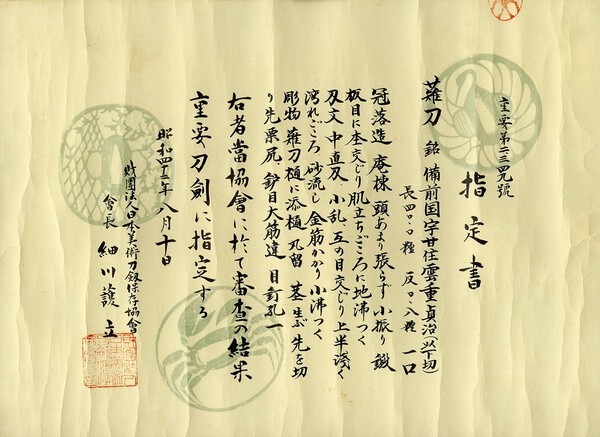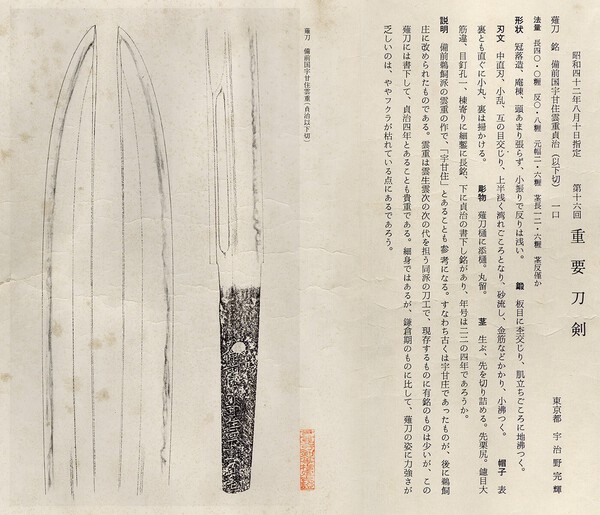
Natichu
Members-
Posts
122 -
Joined
-
Last visited
Content Type
Profiles
Forums
Events
Store
Downloads
Gallery
Everything posted by Natichu
-
Even more interesting that both the nakago and kissaki have been reshaped (presumably to facilitate use as a wakizashi) and yet it still remains a naginata sans naoshi, as it were. Many thanks to you and @Geraint for shining some light on this!
-
Many thanks all. Clearly I have a lot of learning to do, but this is an interesting starting point as I have a strong interest in naginata and naginata-naoshi. @Jacques, are you able to provide any snippets of the zufu where this is listed as a wakizashi? Would that be a bit of a rarity for it to be listed differently than in the origami? I've never had the chance to see the zufu before (unless the page I've added above is from those books, in which case my apologies for misunderstanding!).
-
Good evening all, In continuing my reading and review of the usual sites we all undoubtedly frequent, I came across this piece on Aoi that raised a lot of questions in my mind relating to how the NBTHK categorizes things: https://www.aoijapan...th-nbthk-juyo-token/ Photo of the origami and juyo setsumei attached as well. So, as one can see the blade is currently in wakizashi koshirae. However, it has been categorized as a naginata, not a naginata-naoshi. If my Japanese is correct, the juyo setsumei indicates that the nakago is ubu, but also that it is cut down ("生ぶ、先を切り詰める"). The original mei remains. The kissaki has a kaeri and so as far as I understand it hasn't been reshaped. Questions I have for the members of the forum: 1) As this is now in wakizashi koshirae, with nakago modified to make that happen, why is this not a naginata-naoshi? Is this because the kissaki hasn't been reshaped? 2) What makes a nakago ubu? In this case, it has been cut down, and so it isn't unaltered. But I assume it hasn't been moved up the blade (though I've also seen blades with machiokuri listed as ubu). I appreciate all of this likely is me simply trying to be a bit more fixed in categories than is helpful. But the blade, fittings, and paperwork just stuck in my brain in odd ways, and thought it might make a good set of learning points for me. Any insight anyone can provide would be greatly appreciated!
-
Thank you very much for posting their response! Certainly the ryugo waisted style is an element of Tensho koshirae, but I would not have thought was enough on its own to fit the bill - Markus Sesko, for example, gives a few more what I would have thought defining characteristics. Tsuruta-san undoubtedly knows more than I do though, so appreciate the insight.
-
Many thanks Thomas, that is very much appreciated!
-
Not something that had occurred to me! I had assumed there was a real chance that I was simply wrong in my understanding, so felt more comfortable exposing my ignorance here rather than writing directly to Tsuruta-san (with whom I don't have any existing relationship) to ask for clarification.
-
Very interesting! Not something I've heard before, so very much appreciate it. I assume something along these lines would fit the bill? https://www.flickr.c...s/72177720321619029/
-
Certainly. Glad to know I wasn't totally out to punch thinking that didn't appear to be what I'd describe as a Tensho-style koshirae.
-
That was certainly my take, both the reference to Tensho and mine to Momoyama - stylistic rather than an age statement.
-
I would have thought it was more of the oft-referenced ostentatious Momoyama style koshirae, but glad to know that I'm not the only one that thought it was somewhat loud!
-
Good evening all, Just perusing Aoi (as I'm sure most of us do), and saw that their latest piece has what they have described as Tensho koshirae: https://www.aoijapan.com/katana:fujiwara-masahiro-藤原正弘judged-as-osumi-jo-大隅掾nbthk-tokubetsu-hozon-token/ Image attached as well. To my mind, this doesn't seem to resemble Tensho koshirae at all. That said, I'm a beginner at best, so wanted to get a sense of whether this was an error on Aoi's part or a complete misunderstanding on my part as to what Tensho koshirae is. As I'm a big fan of what I would say is the more textbook stay (see: Markus Sesko's Koshirae Taiken at pages 213-219), this one caught me rather off-guard. Any thoughts or points of education would be very much welcome!
-
Would you knowingly buy a gimei blade?
Natichu replied to KungFooey's topic in General Nihonto Related Discussion
I don't know that I need to leave anything to lay. That said, you're entitled to your opinion and me being wrong wouldn't be the first time in any respect. So happy to simply say we disagree about the matter; I've more than said my piece. -
Would you knowingly buy a gimei blade?
Natichu replied to KungFooey's topic in General Nihonto Related Discussion
No doubt that may well be the case, and you may well be right. That said, many members are contrary in posts, but the reaction seems somewhat singular. I also caveated that with "in general", indicating some posts may have been contrary. At any rate, as with many things to each their own. The reaction just seems somewhat singular and odd, often derailing otherwise productive threads. -
Would you knowingly buy a gimei blade?
Natichu replied to KungFooey's topic in General Nihonto Related Discussion
I have to say, as far as forums getting weird, that might be one of the weirdest posts I've seen in a while! Art with dicks? That all seems a bit over the top. -
Would you knowingly buy a gimei blade?
Natichu replied to KungFooey's topic in General Nihonto Related Discussion
Was thinking about posting something similar myself, but don't know I would be able to put it any better. In general Dee's posts have been positive and contribute to the community. Could they be someone other then advertised? Sure. But as far things have gone I don't see any cause for the weird animosity. -
This triggers my spidey senses
Natichu replied to Lewis B's topic in General Nihonto Related Discussion
I know Jussi and I were briefly discussing this in another thread, and don't know that we ever reached a conclusion. Is it that previously you could submit for both in the same session, and now you can't? Or is it that previously you needed to submit twice to obtain TH, but now can submit only once? Any clarification anyone can provide around which way the process shifted and when would be greatly appreciated! -
Thanks so much for the offer! Unfortunately I don't think that will quite fit the bill in terms of era and size. But I very much appreciate the chance to consider the option! Photos are always welcome, as it all goes into developing my thoughts on what I'd like to buy.
-
Certainly not intends as a correction Jussi - as far as I'm concerned, you're much more likely to be right than I am! I figured I had things backwards. Maybe one of the forums more knowledgeable agents/vendors will be able to weigh in to set us straight one way or the other.
-
Regarding the shinsa process, I had thought it was the opposite - that previously you had to submit twice to get TH, but could now submit once and have it evaluated at both levels. The NBTHK price listing (https://www.touken.or.jp/english/aboutus.html - see Shinsa Price List) seems to indicate you can do both at once. Interesting to see that I've gotten it backwards! Does anyone know when this shift happened?
-
Alternative kanji in kanteisho
Natichu replied to Natichu's topic in General Nihonto Related Discussion
Addendum: have done a little digging, and as this was a post-war change, that certainly clears up the timeline. Thanks again Ray! Initial post: Many thanks Ray! That certainly explains it. Would you say it's accurate to assume that if I see 広 in a modern source, the smith likely signed with the older form 廣? -
Hi all, I've been looking at a few smiths recently with names ending in "-hiro". I've noted that the NBTHK kanteisho (and Markus Sesko's' Swordsmiths A-Z) use the kanji "広", whereas the smiths themselves all seem to have used "廣". In searching on the Nihonto smiths database it looks like there is in fact only one smith with "広" in their name (Munehiro, a Showa era smith). Is the reason for this solely because the 廣 kanji is considered archaic? Or is there something else going on here? Any guidance here would be greatly appreciated. For bonus points, as it were, does anyone know of any other common kanji substitutions used by the NBTHK like this one? Images attached for reference.
-
Excellent timing, as this just came up in Aoi: https://www.aoijapan.com/wakizashi:kawachi-no-kami-fujiwara-kunisuke-first-generationnbthk-tokubetsu-hozon-token/ A shobu zukuri wakizashi (unless you're of the view that unless the shinogi meets the mune directly at the point, it's not a true shobu zukuri), quite lovely to my eye but I'm very partial to that blade shape.
-
Many thanks Jussi, these threads have been a lot of fun thus far and a great way for a beginner like me to start to dive into things a bit more, even if it's just to learn about details I didn't even know I should be considering. And don't worry about not knowing enough Robert, you won't do worse than I am and it's good fun to throw your hat into the ring.
-
Unfortunately I can't quite make out the kanji. Any chance of getting the relevant portion typed out?
-
I think it might bear fruit for some. If you have a deep knowledge of painters, it may give you a mental hook or anchoring point to better remember smiths and some of their qualities (scaffolding off your existing knowledge). Or it might help you understand the relative ranking of smiths' skills and prestige. It doesn't do any of the above for me, but I can see it being both entertaining and helpful for some. After all, someone familiar with swords once said that if you know the way broadly you'll see it in all things.






.thumb.jpg.ee5bac425d23784ecf27e8d9c13b12ef.jpg)




